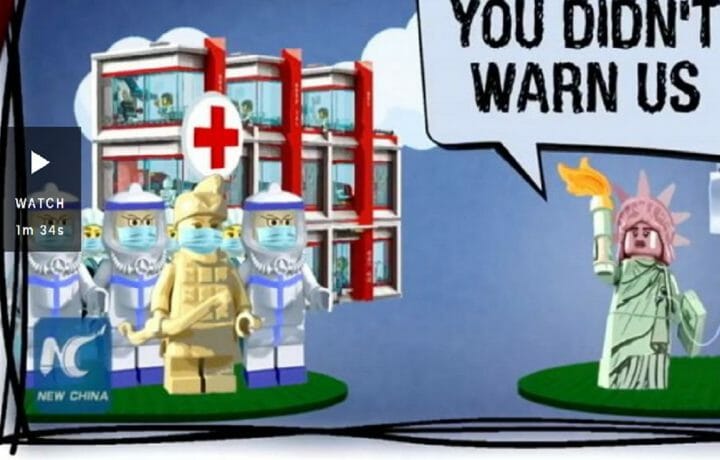In what can only be described as bizarre, China’s Xinhua News began distributing a Lego-like cartoon, “Once Upon a Virus” which pointedly takes a shot at the U.S. response to COVID-19. The timing for the release (29 April) of this short is especially galling. The U.S. has surpassed the one million mark of COVID infected individuals and has seen over 63,000 deaths. The attempt to use satire and sarcasm in this format, at this time, demonstrates the uneasiness China is experiencing as the world is aflame with the coronavirus.
China attempts to take the U.S. to task on the uneven responses which occurred in early-2020 as the world came to learn that no country would be able to avoid the coronavirus.
While there is no denying that the official response within the United States has been uneven, the attempt to juxtapose China and the United States leaves out China’s own missteps. With Lego-like characters and stilted voices the story is told via a timeline of December to April.
The video begins in December, with the arrival of strange pneumonia cases being reported in China, and notes that the World Health Organization (WHO) acknowledgement. It leaves out, of course, the fact that those in China who reached out via social networks to let the world at large in on China’s discovery of COVID in Wuhan were silenced.
Moving into January, the short creates a dialog between China and the U.S. ,where China is providing advice, and taking steps to isolate COVID-19 infected persons. The reaction from the U.S. is projected as universally skeptical or inflammatory. The topics included an early-January dismissal of COVID-19 as nothing more than the flu, to the debate on whether or not a mask should be worn. There is no mention that China purchased millions of dollars worth of Personal Protective Equipment (PPE) from the West in January, when the world was still learning what had been taking place in Wuhan. Nor does it mention the export of poor quality PPE from China.
China also highlights their stay at home order, which is projected as being viewed as a human rights violation. The reality is, video of Chinese government officials welding building doors shut did spark an outcry.
China then pats themselves on the back for building temporary hospitals (which they did in a relatively short time span) and characterizes the U.S. response as claiming China was just a “show off.” When the reality is, the U.S. Army Corp of Engineers eclipsed the Chinese effort many times over as the need for hospital beds was assessed and the Corp of Engineers built field hospitals throughout the U.S.
As the cartoon moved to February, the dialog starts to look at the medical aspects of the COVID-19 response. China’s medical system was overwhelmed in Wuhan and Chinese media showed how 50,000 medical personnel were sent to Wuhan from other areas of China. China acknowledged that their medical personnel were dying and painted the U.S. response as one which lacked empathy and projected an imperialist holier-than-thou attitude toward China as a third-world country. The February discourse concludes with China’s admonishment that the virus is airborne, and recalls sarcastically the statement made by the U.S. administration that the virus would be gone by April.
Moving to March, the LEGO characters discusses how the U.S. (and many other countries) has challenged China on the truthfulness of their COVID-19 disclosures. Among these is the claim China tried to warn the world, but the world wasn’t listening, and now your people are dying. True, people around the world are dying, allegedly in greater numbers than have died in China.
Then the film moves to April and the message shifts from the U.S. (government focus) to Americans – the people of the United States. China pulls out its broad brush and attempts to paint the U.S. as xenophobic, pointing to the review of the WHO and removal of funding by the U.S. administration.
It concludes with a parting shot:
“US: We are always correct, even though we contradict ourselves”
“China: That’s what I love best about you Americans, your consistency”
China: We discovered a new virus.
America: So what?China: It's Dangerous
America: It's only a FluChina: Wear a Mask
America: Don't wear a Mask
… pic.twitter.com/Qxugv8z73J— China Xinhua News (@XHNews) April 30, 2020
The medium of choice for Once Upon a Virus was YouTube, where approximately 56,000 views have taken place. Over in the land of Twitter, where China hoped to place a political marker, the video has garnered approximately 23,000 views.
Some may view this as an editorial effort at satire and sarcasm by a Chinese media outlet. But Xinhua is the voice of the government. It’s important to remember that even though we in the west enjoy the freedom of satire, such is not the case in China, where dissenting opinion is hammered into submission.
This effort by Xinhua is designed to ridicule the United States, while poking fun at the number of COVID-19 deaths in the U.S. No doubt the low audience numbers tell the tale, it is not a huge success.
No doubt China had hoped to deflect the discussion from China’s lack of early transparency and continued suppression of publication of research on COVID and paint the situation in the U.S. as one of its own making. Instead, the U.S. Director of National Intelligence has opened an inquiry into the origins of COVID-19.




